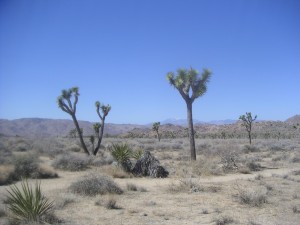
I recently helped guide a 50 mile trip through Joshua Tree National Park. If you have not been to Joshua Tree, you may not know it as a national park made up of two distinct geographic terrains, both of which happen to be deserts – the Mojave and the Colorado. Yes, there are some places in the world where one desert just isn’t dry enough, you have to have two!
Because water is so sparse in these deserts, even if you can find it you can’t legally drink it.
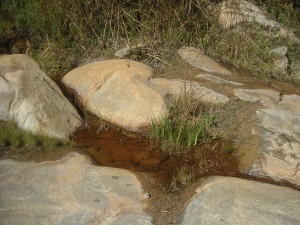
It is strictly reserved for the local wildlife, who clearly knew enough to make advanced reservations.
So what’s a thirsty backpacker to do?
Carry On Luggage?
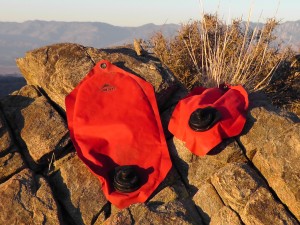
One option for water is simply to carry it. In a hot desert there are probably not many things you will be carrying more important than water. Traveling in heat most backpackers require at least a gallon of water a day. In the unlikely event that you don’t remember, a gallon of water weighs 8 pounds. On this particular trip we came across a solo female backpacker who was carrying 4 gallons of water. Yes, 4 x 8 = 32 pounds of water. This was of course in addition to the rest of her gear, bringing to mind two words: stud and nutjob.
Our week long trip in the desert would therefore require 7 days x 8 pounds = 58 pounds of water per person. A standard rule of thumb for pack weight is 25% to 30% of your body weight. So if your body weighs 150 pounds, your pack (with water, food, tent, stoves, fuel, sleeping bag, etc) should weigh between 37 pounds and 45 pounds. Unless you are carrying a lot of helium, I am not sure how you squeeze 58 pounds of water into that total weight range.
So again, what’s a thirsty backpacker to do?
Cache for Gold?
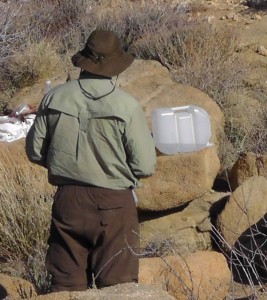
Although cache sounds like cash, it’s not about money. It is, however, about a hidden treasure even more valuable, water. By hiding water at strategic locations along your route you significantly decrease the amount you need to carry.
This perhaps raises some immediate questions I will attempt to anticipate and address.
If I can’t carry enough water during my trip, how can I carry enough to go hide it?
Good point. Caching water does not usually mean hiking the exact same route carrying all the water you will need. It usually involves multiple shorter trips, carrying only what you will need when you reach that particular location. For our 50 mile hike we made a cache advance deposit of water in 3 different locations. Between each location, we got back in our car and drove somewhere closer to the next cache site. Although our total ultimate trip would be over a 50 mile route, the furthest we had to carry water jugs for caching was a couple of miles.
How do I know the water I hide will still be there when I need it?
Short answer: you don’t. Long answer: you hide it well enough that no one else will ever find it. As a practical matter most fellow backpackers who stumble upon your cache will respect your need and leave it alone. If however, they feel an even greater need than yours they may be tempted to make a cache withdrawal. It is possible you may find a thank you note or an apology note instead of your water. I highly doubt it though. No one writes notes anymore.
If I hide it really well, will I be able to find it?

Good question. Maybe you won’t. One point in your favor is that you will be highly motivated to find it. Some techniques to help find it, in ascending order:
- bring someone with a really good memory and sense of direction
- take really good written notes, describing milestones and markers
- take a digital picture of the location and surroundings
- take a GPS waypoint of the cache (my preferred method)
As encouragement for your search, I offer this tale of truth. On our Joshua Tree caching expedition the lead guide remembered caching water 3 years previous, which was never retrieved. Given there is no time limit on leave-no-trace guilt, he was determined to find the stray plastic jug. His search strategy was based on the following:
- I think it might have been up this wash
- No, wait, actually it might have been that one
- I remember a tree, but I think it was bigger than this one
I am happy to say he did not take me up on any of my financial offers regarding the odds of a find. To my total amazement he dipped behind a Joshua tree (which looked to me no different than the thousands of others available) and calmly said “found it.” In case you are wondering what three years of UV light in the desert does to a plastic water bottle, let’s just say it did not improve it. The water, clearly tired of waiting to be found, was long gone. None the less we carried out in victory the remaining pieces, restoring the desert to its original pre-plastic state.
Are there rules for caching?
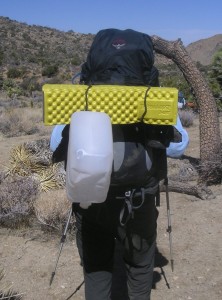
Yes. Each land manager has their own cache and carry rules, but they usually involve:
- what, if anything, can be cached (water, food, gear)
- how it must be marked (name, date, phone number)
- how long it can be cached (how far in advance, total time)
- pack it in, pack it out
As you recover and use your cached water jugs, you will have to carry out the empties. You can simply cut them up and hide them in your stash of trash. Another option to consider, however, is to display them proudly on your pack, making your water caching cleverness clear for all to see… or at least to the two or three others backpackers you might stumble across in this wonderful waterless wasteland.
